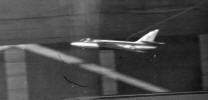|
Letter to RAFMAA Newsletter Editor Dated 22/05/06
Dear Editor,
I've recently been browsing the RAFMAA Web site and found it most interesting. I was in the RAF from 1946-60 having trained at RAF Halton. For most of that time I was a very active aero-modeller and a member of the RAFMAA. In 1953 I flew in the RAF Championships held at RAF St Athan and was the winner of the Victor Ludorum trophy, I am standing in the centre of the prize winning photo, behind the Aeromodeller Trophy.
You have asked for any further information on the photos shown in the history of 1950-53. I have a lot of photos from that period if you would be interested, including many of the Hawker Hunter display built by my friend Cpl Dan Barker and I for the RAF recruiting stands at major London Exhibitions such as the School Boys Own during 1953-54.
With regard to the
photos at present on the 1950-53 RAFMAA Archive photo page, I have
attached a combination photo giving some further details, plus a
correction. The "Wattisham Witch" was built by SAC Williams of 32 MU
RAF St Athan and not by Flt Lt Robertson. It flew in the unorthodox
event at the 1953 Championships and also as a 'slope soarer'
somewhere in Wales. I can't remember how successful the Autogyro was
that Ken Gardener built, but the Tipsy Junior flown By Dan Barker,
took part in the Scale Stunt event at the 1953 Championships. The
final photo is of the 1953 winning Class 'B' Team racer, it
was built during the midnight hours over three nights!! and was
powered by an ETA 29. Photo: 1953 winning Class 'B' Team racer, it was built during the midnight hours over three nights!! and was powered by an ETA 29.
I am on the left of the photo, my nickname dating from Halton was and still is 'Nobby', Dan (Cpl) Barker is in the middle and Andy Andrews on the right. In the final of the Class 'B' team race in 1953, we beat our friend and arch rival Sqn Ldr Verney, to our huge delight, hence the broad grins. Yours sincerely Arthur.E.Burch (Cpl in 1953) |
|
Further to Arthur Burch’s initial letter, Arthur has kindly provided the information and pictures for the Hawker Hunter Round-the-Pole Display. These picture and text will be included in the RAFMAA History pages on the Website. (Ed)
In early
1953 my friend Dan Barker and I were stationed at 32 MU RAF St.
Athan. We were given the task of producing a model
flying display to be used on RAF recruiting stands at big
exhibitions and shows around the country. The first of these was to
be the Earls Court Radio Show in late
Our first
attempt at an RTP model, was an Electric Ducted Fan powered Boulton
Paul BP 111, an Experimental Delta. Although it did fly, our fan was
very inefficient and despite putting 48 volts through the 24 volt
motor, there was not much power. One of us came up with the idea of
using a compressed air jet, with the air supply being fed to the
plane down a plastic tube, from a rotating banjo union on the
centre
pole. This proved to be the answer and performance was
good, providing we had an ample supply of air.
About this time, the Hawker Hunters were soon to enter service and there was a 'Jetex' Kit for this aircraft on the market. It had a span of around 18 ins. and a length of 20 ins. this seemed to be an ideal choice provided we could adapt it to our needs. To help make them more representative of the Hunters coming into service we were given the serial numbers of the first batch of aircraft. WT 555 to WT 560.
To make our Hunters more realistic I designed a retracting undercarriage, powered by a 24 volt electric motor. This worked on the screw-jack principle, where the nut cannot be pushed along the thread. This gave effective locking in both up and down positions, see my drawing, which shows how it operates. The double worm drive reduction gearbox was designed and built by a skilled instrument maker, Vic Quelch, who also made all the brass end fittings for the push rods.
The centre pole had as its base, a supercharger impellor from a Rolls Royce Merlin with the blades machined off. We used to fly two aircraft in formation and each plane had its own swivelling head on the pole. This banjo type connection fed the air to the model via a 1/4 ins. neoprene tube and three slip rings fed the electric supply down fine wires to the undercarriage motor.
The Airfield
was 30 ft. diameter, with a flat outer runway, this was built in 8
sections for ease of transport. Incorporated in the outer runway,
were retractable guide rails which were used to steer the nose wheel
of the model, on leaving the runway, to follow a fixed rail on the
taxi-way up and over the centre part of
The outer
plane would fly at up to 60 mph and it was very tricky to fly two in
formation. Due to the different radiuses
purpose by helping the recruiting policy of the RAF. I hope this story and the photos will be of interest to the RAFMAA's history, and I hope also that it stirs some memories for other members.
Your sincerely, Arthur Burch (ex. Cpl. in 1953)
Many thanks to Arthur for his help with providing some more detail for our existing archived RAFMAA photos and especially for his efforts to bring us this fascinating story of his endeavours to create a truly brilliant working model display. If anyone has information of what happened to this amazing creation, especially the fully functional Hunter display undercarriage built onto a Perspex plan outline of the Hunter please get in touch with me, top of page
|



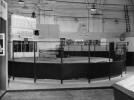
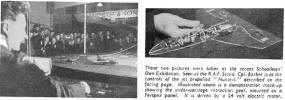
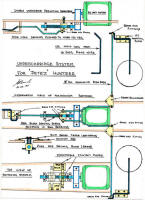

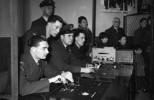

 The show
attracted a great deal of interest and hopefully fulfilled its
The show
attracted a great deal of interest and hopefully fulfilled its 